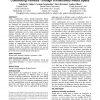1136 search results - page 55 / 228 » Processing-in-Memory: Exploring the Design Space |
117
click to vote
CE
2004
15 years 12 days ago
2004
Much computer-based learning is largely passive, based primarily on task-based, exercise-driven interactions. We argue that computers have greater potential for promoting more act...
112
click to vote
ECML
2006
Springer
15 years 4 months ago
2006
Springer
In many complex machine learning applications there is a need to learn multiple interdependent output variables, where knowledge of these interdependencies can be exploited to impr...
132
click to vote
CHI
2011
ACM
14 years 4 months ago
2011
ACM
Video conferencing allows distance-separated family members to interact somewhat akin to being together at the same place and time. Yet most video conferencing systems are designe...
114
Voted
LCTRTS
1999
Springer
15 years 4 months ago
1999
Springer
Code space is a critical issue facing designers of software for embedded systems. Many traditional compiler optimizations are designed to reduce the execution time of compiled cod...
100
click to vote
HPCA
2007
IEEE
16 years 28 days ago
2007
IEEE
We apply a scalable approach for practical, comprehensive design space evaluation and optimization. This approach combines design space sampling and statistical inference to ident...


